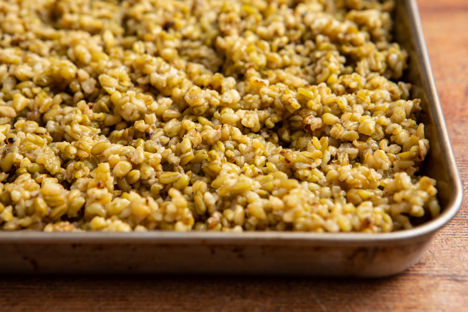Freekeh (also called farik or frik) is the green-brown grain of durum wheat. It has a tender, toothsome texture and a nutty, smoky flavour, which comes from the unique methods used to harvest it. The discovery of freekeh is said to have been an accident: in an attempt to sabotage a Mediterranean crop by burning, soldiers actually gifted this grain to locals who, when attempting to salvage the wheat, found that the slightly smoky, young grains were delicious. A new way of eating wheat grain was born.
How is freekeh made?
The production of freekeh is unique. When the grains are young and soft, the wheat is piled and allowed to dry out in the sun. Once dry, the piles are strategically lit in order to burn the straw and chaff, while the seeds survive, protected by their high moisture content. What also remains, however, is a smoky flavour from the fire. The now-roasted wheat is then threshed (rubbed) and sun dried once more. Finally, the grains are cracked into the smaller green grains we most commonly buy in the shops, although wholegrain freekeh is also available.
Is freekeh the same as bulgur?
No, freekeh is not the same as bulgur. Although they both come from the same plant, freekeh is the immature green kernels of wheat, while bulgur is fully matured.
How to prepare freekeh
Prepare freekeh by giving it a good rinse in cold water before boiling, to remove any pieces of dirt and other debris that may be left behind from the production process.
How to cook freekeh
Freekeh is simply boiled in water or stock. As a general rule, use a ratio of 1 part freekeh to 2.5 parts water or stock.
Metric
Imperial
- 200g of freekeh, rinsed
- 500ml of vegetable stock, (or water)
Rinse the freekeh to remove any dirt or debris
In a saucepan, combine the freekeh with the water or stock and bring to the boil. Reduce to a simmer, cover and cook for 15-20 minutes (or until tender) for cracked freekeh, or 35-40 minutes (or until tender) for wholegrain freekeh
Drain any excess water (this should be minimal if present) and fluff up the freekeh with a fork
How to store freekeh
Store uncooked freekeh in a tightly sealed container in a cool, dry place. It will last up to two years when stored correctly.
Cooked freekeh should be stored in a sealed container and refrigerated for 3 days, or frozen for up to 6 months.
What to do with leftover freekeh
Leftover freekeh is a very handy ingredient to have in the fridge because it’s so versatile. Try using freekeh to bulk out salads, such as this stunning freekeh and artichoke salad from Peter Gordon, or combine it with dried fruits and herbs to make a satisfying stuffing for a roast chicken, such as this apricot and freekeh stuffed chicken from GBC Kitchen.
Recipe ideas for freekeh
The nutty flavour of freekeh pairs particularly well with dried fruits such as apricots and cranberries, and with bold herbs, such as parsley, coriander and mint. It’s also a versatile grain that can be used in place of couscous or bulgur, such as in this freekeh, aubergine and cashew tagine from Marcus Wareing, which is also vegan. If you’re looking for something meatier and show-stopping to boot, try this balsamic-glazed hogget shoulder with freekeh and grilled radicchio from Ramael Scully, which would make a truly impressive centrepiece!
Get in touch
Please sign in or register to send a comment to Great British Chefs.



